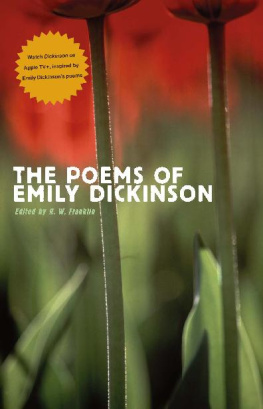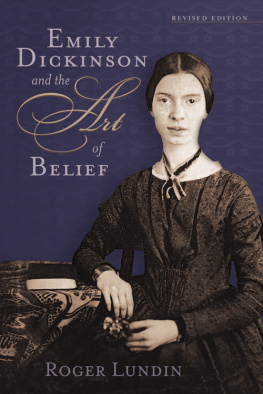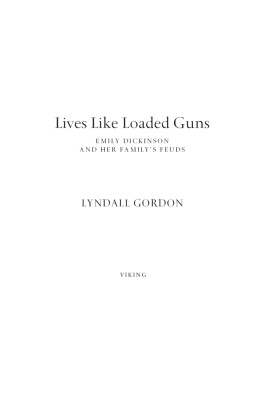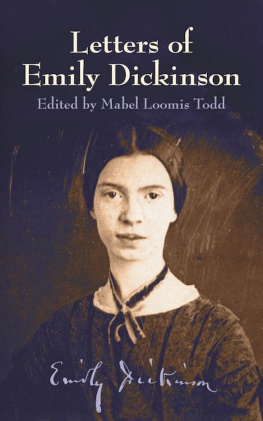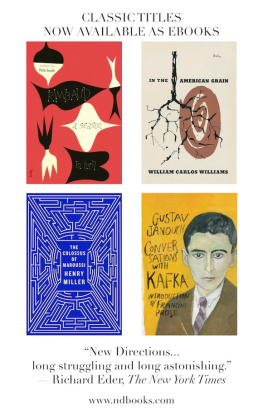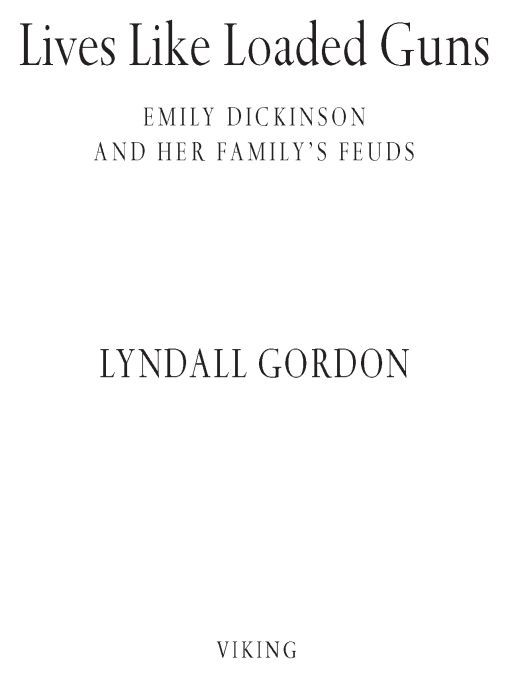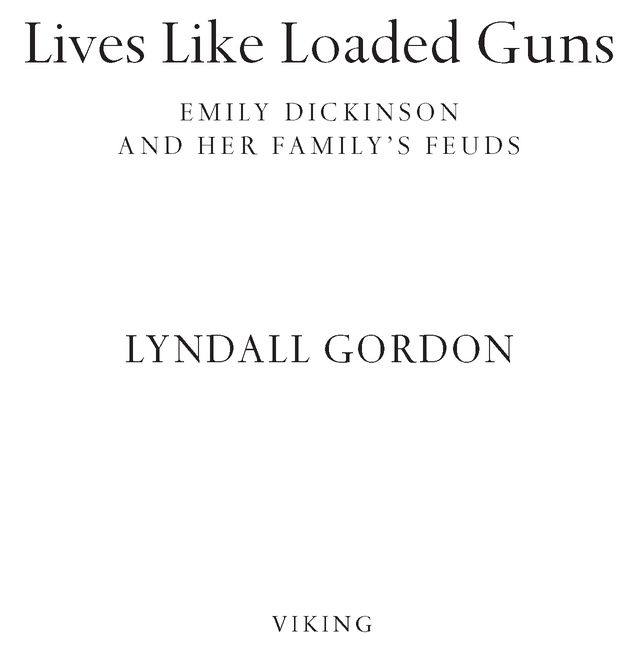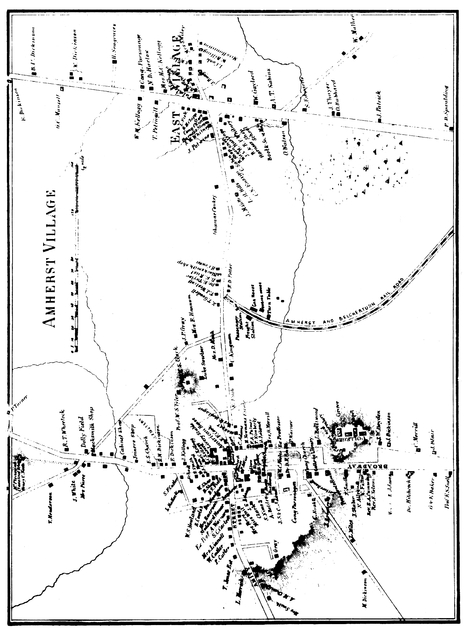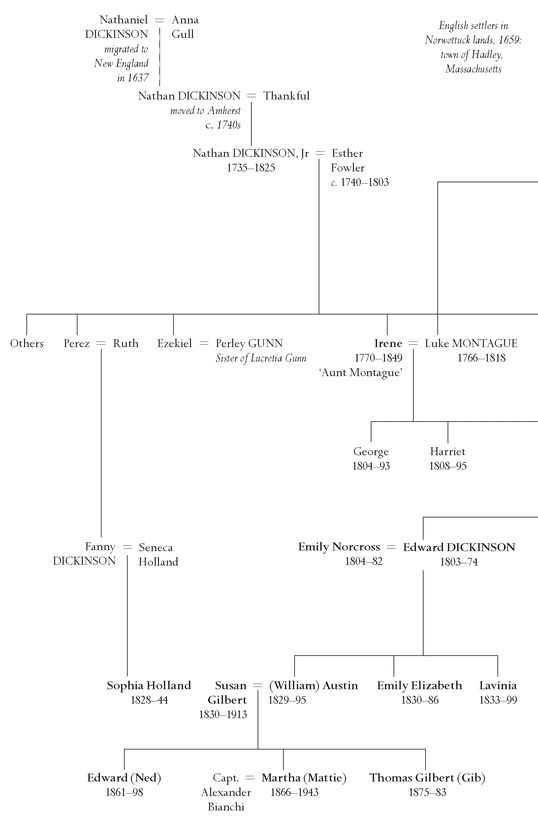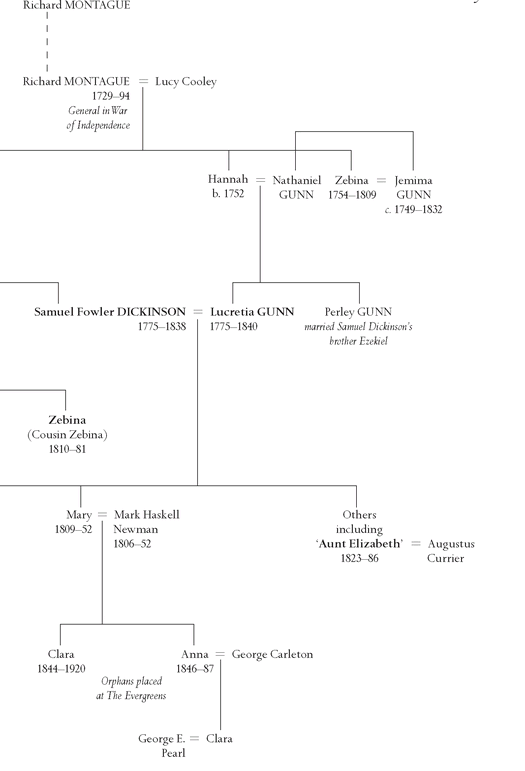Table of Contents
Also by Lyndall Gordon
T. S. ELIOT: AN IMPERFECT LIFE
VIRGINIA WOOLF: A WRITERS LIFE
SHARED LIVES (A MEMOIR)
CHARLOTTE BRONT: A PASSIONATE LIFE
A PRIVATE LIFE OF HENRY JAMES: TWO WOMEN AND HIS ART
VINDICATION: A LIFE OF MARY WOLLSTONECRAFT
My Life has stooda Loaded Gun
EMILY DICKINSON
It was a devilish situation for everyone concerned
MILLICENT TODD BINGHAM
In memory of
Diane Middlebrook,
biographer and friend
The Dickinson Family Tree
IN ORDER OF APPEARANCE
WILLIAM AUSTIN DICKINSON: Only brother to the poet, Emily Dickinson. Lived next door at The Evergreens in Amherst, Massachusetts.
SUSAN (SUE) DICKINSON: Girlhood friend, sister-in-law and keen reader of Emily Dickinsons poems. Shared books with the poet.
LAVINIA (VINNIE) DICKINSON: Emilys devoted younger sister.
MABEL LOOMIS TODD: Co-editor and then editor of the first volumes of Emily Dickinsons poems and letters. Austin Dickinsons mistress.
DAVID PECK TODD: Professor of astronomy at Amherst College and philandering husband of Mabel Todd.
EDWARD DICKINSON: Formidable father of Austin, Emily and Vinnie.
MRS DICKINSON: Emily Norcross Dickinson, wife of the above.
COUSIN ZEBINA MONTAGUE: An invalid of sorts living in seclusion with his sister Harriet, almost opposite the Dickinsons.
MARY LYON: Founder of Mount Holyoke College in 1836 and still presiding in 1847 when Emily Dickinson arrived.
JANE HUMPHREY: Schoolmistress. Emily Dickinsons beloved friend.
BENJAMIN FRANKLIN NEWTON: Young lawyer in Edward Dickinsons office and first mentor to the poet after college.
MARTHA (MAT) GILBERT: Elder sister of Susan Gilbert. Confidential girlhood friend of Emily Dickinson.
KATE SCOTT TURNER: A young widow, one-time school-friend of Susan Dickinson.
SAMUEL (SAM) BOWLES: Editor of the Springfield Republican, who published some of the poets most daring works in the early 1860s.
MARY BOWLES: Unhappy, invalidish wife of the above, alternately teased and comforted by Emily Dickinson.
LOUISA (LOO) AND FRANCES (FANNY) NORCROSS: Cousins and intimates of Emily Dickinson.
JAMES JACKSON: Distinguished Boston physician, consulted in difficult cases. Emily Dickinson saw him when she was twenty years old.
THOMAS WENTWORTH HIGGINSON: Boston man of letters, sympathetic to aspiring women. Co-edited the first volumes of Dickinsons poems.
HELEN HUNT JACKSON: Amherst schoolfellow and supporter of Emily Dickinson. Well-known writer on the wrongs of Native Americans.
JUDGE OTIS PHILLIPS LORD: Friend of the poets father, who became a suitor of Emily Dickinson.
EDWARD (NED) DICKINSON: elder son of Austin and Susan Dickinson, nephew to Emily Dickinson.
MARTHA (MATTIE) DICKINSON (MADAME BIANCHI): only daughter of Austin and Susan Dickinson. Loyal to mother and Aunt Emily.
MAGGIE MAHER: Servant to the Dickinson sisters.
MILLICENT TODD BINGHAM: Studious only child of David and Mabel Todd. Inherited her mothers chest of Dickinson Papers.
ALFRED LEETE HAMPSON: Companion to the poets niece Mattie Dickinson Bianchi. Heir of the Dickinson Papers. Married Mary Landis.
WILLIAM (BILL) MCCARTHY: Agent for the Dickinson Papers.
GILBERT MONTAGUE: Donor of the Dickinson Papers to Harvard.
WILLIAM JACKSON: Curator of the Houghton Library, who acquired the bulk of the Dickinson Papers.
NOTE ON TYPOGRAPHY AND PUNCTUATION
Since Dickinsons poems were almost all unpublished in her lifetime, and since she did not authorise the forms in which the ten printed poems appeared, there can be no secure typography and punctuation. Only a facsimile edition or scanning could include the variety of Dickinsons dashes. Since no typographical equivalent exists, I resort to a long dash for poetry, so as to register a signal more significant than an ordinary dash between the words.
Dickinsons subjective capitalisation is preserved in all quotations but not her lineation where it is impossible to be certain whether a line ends or runs on at the edge of her manuscript page.
Dates of Dickinsons writings are approximate, the cumulative but uncertain fruit of scholarship since the late 1880s.
I: A POET NEXT DOOR
In 1882 Austin Dickinson, in his fifties, fell in love with a young faculty wife. Twenty-six years before, Austin had married Susan Gilbert, the friend of his sister. The Evergreens was built to accommodate the married pair next door to the family home on Main Street in the country town of Amherst in western Massachusetts. By the 1880s Austin was the leading figure in the community; townsfolk called him the Squire, a standing he inherited from his father. No one was more respected than the tall Squire when he appeared in his black hat at a straight angle over his eyes. There was a spring to his stride, led by a cane, along Main Street. His mouth turned down and the expression on his lined face was austere. A devout member of the church, he reproved laughter on Sundays; of late he had turned his considerable taste to improving the graveyard. In every particular, Austin Dickinson appeared an unlikely candidate for the folly of passion.
Watchful eyes in a New England town of only four thousand meant that assignations had to happen in strictest secret. The only safe place was the irreproachable Homestead, next door to The Evergreens, where the Dickinson sisters continued to live. Even there, nothing was said to acknowledge the romantic and then adulterous nature of Austins attachment to Mrs Todd. A fiction was maintained that Mrs Todd was no more than a special friend to all the Dickinsons. But one member of the family refused to collude: Austins distraught wife. When protest, then humouring, proved useless, rows exploded in the privacy of The Evergreens.
The rows came to a head in the winter of 1885. On the night of 25 January, Susan Dickinsons nails gashed the wallpaper in the hallway, the rents gaping for any caller or servant to see. Her husband, being the pink of propriety, had to capitulate. Ostensibly it was an issue of refurbishment, but really about silence: a husbands refusal to speak to a protesting wife. Three days later, the last of the marital decor had been stripped from the walls. Dark-red wallpaper with a fashionable William Morris design was brought in from Galloway & Fitch to cover the damage.
Susans breakout hardened her husband. Their son, prone to seizures, sided with her but was helpless against his father and nothing could stop the course of havoc Austin Dickinson was cutting through his family. Following the wallpaper incident, Susan and her son sank into poor health in the course of that winter.


